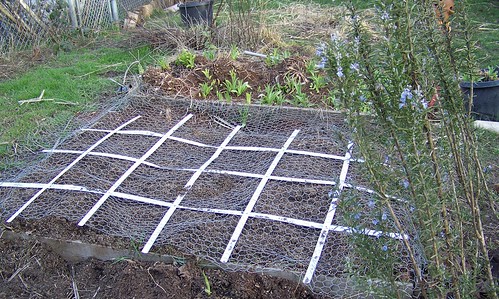
For this week's Real Food Wednesday blog carnival I'll tell you a bit about my gardening experiment. I've been wanting to garden for years but the school/seasonal job year happens to perfectly bisect the growing season year. It's hard to get excited to plant stuff in April and May when you know you are going to be moving in June or July. Luckily for my gardening aspirations I have a "real" adult job this year and no plans of moving anywhere! I am
 actually going to be planting two gardens this year, one in the little yard at my duplex and a bigger one in my parents' backyard up the street.
actually going to be planting two gardens this year, one in the little yard at my duplex and a bigger one in my parents' backyard up the street.Last fall I bought a copy of Mel Bartholomew's All New Square Foot Garden and have been reading it voraciously. Square foot gardening is an intensive planting method using prepared soil (instead of native garden soil and amendments) that is designed for people who want the joy of gardening without the hassle of huge harvests or the hard work of tilling and weeding. As I do more reading about it I see some draw backs, but for the first year of my garden experiment I am willing to give it a try. The basics of square foot gardening include the square foot grid that you plant within and Mel's Mix soil. Both take a little work up front, but I think they will repay serious dividends over the course of the year.
My garden at my parent's house is a 4x6 foot plot that had tiger lilies in it for the last few years. If you ever want to do some hard work, dig out overgrown lilies. I'm afraid I won't enjoy the blooms this year :) I du g the bulbs out and laid in a couple layers of mulch and peat moss and then covered it with about 5 inches of Mel's Mix from the book.
g the bulbs out and laid in a couple layers of mulch and peat moss and then covered it with about 5 inches of Mel's Mix from the book.
 g the bulbs out and laid in a couple layers of mulch and peat moss and then covered it with about 5 inches of Mel's Mix from the book.
g the bulbs out and laid in a couple layers of mulch and peat moss and then covered it with about 5 inches of Mel's Mix from the book. Mel's Mix is a 1:1:1 ratio mixture of vermiculite, peat moss and mixed compost. At first I was put off by the "buy stuff" nature of the Mel's Mix but I decided to go for it. I tried container gardening in a mixture of wood compost, top soil and native garden soil last summer and all my plants starved to death. I was willing to put out some expense to get usable vegetables this year :) I was able to purchase all three of these ingredients with minimal hassle or expense. I purchased a 4 cubic foot bale of compressed peat moss for 10 dollars, 3 one cubic foot bags of compost (steer, chicken and mushroom) for 5 dollars a piece and the 3 cubic foot bag of vermiculite for 50 dollars. The vermiculite is clearly the expensive part of the formula but it provides good structure and air pockets to the soil and really should be a one time investment. In the future I will have a compost system set up so I won't have to buy compost, and that looks like the only thing you have to add in the future anyway.
Over the Mel's Mix I laid my grid. Mel recommends wood lath to form the grid but I happened to have a bunch of broken venetian blinds laying around so made my grid out of that. The square foot gardening method calls for planting a proscribed number of plants in each square foot, alternating what plants are in each square. It's a block planting syste m instead of a row planting system, but the plants have the same room around them in the end. For instance, you plant 4 lettuce plants in a square which is equivalent to the "thin to 6 inches" instructions on the back of the seed packet.
m instead of a row planting system, but the plants have the same room around them in the end. For instance, you plant 4 lettuce plants in a square which is equivalent to the "thin to 6 inches" instructions on the back of the seed packet.
 m instead of a row planting system, but the plants have the same room around them in the end. For instance, you plant 4 lettuce plants in a square which is equivalent to the "thin to 6 inches" instructions on the back of the seed packet.
m instead of a row planting system, but the plants have the same room around them in the end. For instance, you plant 4 lettuce plants in a square which is equivalent to the "thin to 6 inches" instructions on the back of the seed packet. The other really amazing part of the square foot gardening book is the time tables in the back for when to plant. He lays out a planting schedule based on weeks before or after your local last frost date so you can use the system almost anywhere. Here in Portland, OR our last frost date is in the second week of April so I am already planting some hardy spring plants. I have already planted snow peas, lettuce, turnips, mustard, radishes and onions, and will plant some chard, bok choy, more onions and lettuce, and kale or broccoli before the spring is too much further along.
Later in the summer I will plant tomatoes, cucumbers and zucchini but haven't decided exactly how to fit those into my gardening plans. Mel Batholomew claims you can plant all of those plants in the square foot garden with trellises, but I'm thinking I may use the plot at my house for a less structured garden with more room for each of those big plants.
My next big challenge is protecting the garden. First and foremost I need to protect it from the  two big black dogs that share the backyard with my garden. My dad's dog particularly likes to dig but both will tromple right through it given half a chance. Right now I have chicken wire laid over the soil but once things start sprouting I am going to need to change that a bit. I've got some ideas floating around in my head, but we'll see how any of it actually works out :)
two big black dogs that share the backyard with my garden. My dad's dog particularly likes to dig but both will tromple right through it given half a chance. Right now I have chicken wire laid over the soil but once things start sprouting I am going to need to change that a bit. I've got some ideas floating around in my head, but we'll see how any of it actually works out :)
 two big black dogs that share the backyard with my garden. My dad's dog particularly likes to dig but both will tromple right through it given half a chance. Right now I have chicken wire laid over the soil but once things start sprouting I am going to need to change that a bit. I've got some ideas floating around in my head, but we'll see how any of it actually works out :)
two big black dogs that share the backyard with my garden. My dad's dog particularly likes to dig but both will tromple right through it given half a chance. Right now I have chicken wire laid over the soil but once things start sprouting I am going to need to change that a bit. I've got some ideas floating around in my head, but we'll see how any of it actually works out :) I'm dreaming of lettuces and radishes out of the garden, tomatoes warm from the vine and cucumbers plumping in the sun. Spring, however, is wet and long here in the pacific northwest and it will be quite a few months before there are any backyard barbecues featuring garden fresh onions and zucchini. Ya know what though, the rain doesn't seem to bother me quite as much when I know it is watering my garden for me :)
Looks great! I'm always encouraged when I read about the gardening efforts of others.
ReplyDeleteHi Alyss,
ReplyDeleteHave you seen this blog yet: http://www.gardenertofarmer.net/ She is from Portland and has a new gardening book out and a great facebook forum for gardening, very active. She's awesome. I can't wait to put my starts in! Not sure how we differ for last frost here in Seattle from Portland but I've had my tomato starts going inside under lowered fluorescent lights for a month now. I won't put them out until May and then I have cleaned milk jugs to put over them to protect them at night until the first of June, and red plastic to put over the soil around them to keep it warm. Tomatoes are a hard one in the Pacific NW but I am planning a tomato triumph this year.
I love your layout. So excited for your garden! I've seen his book many times.
xo,
Sustainable Eats
Thank you for this
ReplyDelete